Articles of 2005
25 years later, the fighters of Mariel
Carlos Albuerne left Cuba with only the clothes on his back. He gathered one of his brothers and a small group of friends and they pushed their way on to a crowded vessel that was pointed north. The only clear vision he had of that day was his dream of fighting for a world title. This, figured Albuerne, was the chance of a lifetime.
More than 100,000 other Cubans agreed with him.
The Mariel Boatlift began April 20, 1980 when Cuban president Fidel Castro declared the port of Mariel open to those wishing to leave the island. At least 1,700 boats, most from South Florida, arrived in Mariel to pick up and transport Cubans to freedom. It ended on October 31 of the same year and it is estimated that 125,000 Cubans fled Castro’s communist way of life.
In what was initially supposed to be relief for those seeking political asylum, Castro opened his prisons and mental institutions and allowed an array of troubled individuals to leave with those who opposed the Communist party. The political opponents were labeled gusanos (worms) by Castro, as for the rest, it was simply a way to transfer his headaches to the United States.
Thus, those arriving in the United States did so under a shroud of suspicion. No one was quite sure who was a political prisoner or a petty thief or a murderer. Then, the opening scenes of the 1983 film “Scarface,” during which Al Pacino’s murderous character arrived on the Mariel boatlift, did more to tarnish the reputation of the refugees than Castro ever could.
“There were maybe 5,000 hardcore criminals out of 125,000,” said Enrique Encinosa, a Miami-based author and boxing historian. “And I’d say maybe 1,000 of them killed one another off in the first year-and-half. Yes, crime did go up. But not for long. A lot of people came over with criminal records. But it was because they were sent to jail for having more than the five pounds of meat that the government rationed to the people.”
In the mix that was sent adrift in the Atlantic, a handful of boxers washed ashore with the rest of the exiles. With professional boxing banned in Cuba since 1962, the Cuban Olympic boxing program was at the height of its dominance in 1980. But the fighters who left on that massive flotilla enjoyed only moderate success boxing in the United States.
“I came to America so I could continue boxing,” said Albuerne, speaking through translator and New York-based journalist Mario Gonzalez.
Albuerne, a junior lightweight, was moved to an U.S. Army base in the south with thousands of other refugees. After being detained for three months, he made his way to Boston and continued fighting as an amateur. In 1982, he settled in Miami and turned pro.
Of the Marielitos who fought professionally in America, only a few reached world-class status. Among them were Pedro Laza, Mauricio Rodriguez and Luis “Kid” Monzote.
Monzote boxed at junior flyweight and decisioned former champion Prudencio Cardona in 1987. The southpaw followed that up by winning the WBC Continental Americas title and, in 1990, he challenged world champion Humberto Gonzalez at the Great Western Forum in Inglewood, California. Monzote was stopped in the third round.
Laza (29-7) fought Cornelius Boza Edwards on national television and Rodriguez (39-3) won a WBC Continental Americas junior welterweight title. After their careers, Monzote and Rodriguez both spent time in prison.
“As a group, they didn’t pan out very well,” said Encinosa, who managed the career of Remigio Carrillo. The welterweight was 6-1 as a pro before he decided to join Miami’s workforce.
“Some of them, like Carrillo, got frustrated,” said Encinosa. “Some of them just left to do other things. Sometimes minimum wage can be better than toiling in the gym for months for free. No one from the national team came over. There were some fairly well-known second- and third-string fighters. Some of them weren’t seasoned enough. Some of them were too old by the time they got here. Some of the fighters were frustrated because they were pampered in Cuba and not pampered here.”
While Marlielitos like Albuerne, Raul Hernandez and Eduardo Lugo did not have impressive statistical records, they were considered sturdy trial horses. In 19 career fights, Lugo managed to squeeze in bouts against Buddy McGirt, Gene Hatcher, Johnny Bumphus and Frankie Randall. He lost each one of those contests.
“These guys were very tough, tough opponents,” said Encinosa. “They didn’t have the patience to sit around and wait. They needed the money and that was the name of the game. A guy like Lugo would rather fight someone tough like Hatcher, for more money, than fight five or six preliminary bouts that he could win. Lugo was always in a war.”
Perhaps the most notable athlete to arrive via the boatlift was Barbaro Garbey, who spent three years in the majors and played for the Detroit Tigers 1984 World Series championship team. Garbey is the uncle of Cuban boxer Ramon Garbey, who defected in 1996 just six days before Joel Casamayor.
In theory, the boatlift was conceived for Cubans like Antonio “Puppy” Garcia. He described himself as a Prisoner of War and had the scars to prove it. Garcia, one of the most beloved fighters on the Havana fight scene of the late 1950s, came to the United States via Mariel. He died at the age of 72 in Miami on October 23, 2005. Before his death, he conducted several interviews with this writer concerning his life in the ring and his political journey.
At the end of his career, somewhere between 1959 and 1960, Garcia was on the verge of fighting Hogan Kid Bassey for the world featherweight title. He was unbeaten over his last dozen fights but the changing politics of his country forced him into inactivity.
“Angelo Dundee and my manager were working on that title fight,” said Garcia. “It was supposed to be in the Orange Bowl.”
Garcia was a national featherweight champion and enthralled the public with a brutal three-fight series with compatriot Ciro Moracen at El Palacio Deportes in Havana. In a sense, he was boxing royalty, fighting first in the shadow of his older brother Lino, a top featherweight who went 10 rounds with Hall-of-Famer Sandy Saddler in Havana in 1947. Quickly, though, Puppy began to outshine his brother.
“The biggest idol in Cuba was Puppy Garcia,” said Dundee. “He never made a bad fight. He was exciting. He was a brawler and a bleeder. They loved him in the fight clubs in Havana.”
“I started boxing professionally when I was 16 years old,” said Garcia. “I think the reason I had so much sympathy from the public was because I used to bleed a lot. That’s why I was so popular.”
The adoration Garcia received from the boxing public only made his political problems worse. In 1961, at 4 a.m., a group of Castro’s soldiers busted into Garcia’s home and took him away. Garcia, who was 27 at the time, refused to support the Communist party and thus spent the next nine years in prison.
Garcia became a convenient target, one that Castro used as a symbol of the government’s power. If they could bring a man like Puppy Garcia to his knees, no man was truly safe.
“I was against the Communist party so I went to jail,” he said. “While in prison, in 1963, we were celebrating the 24th of February, which is a very patriotic day in Cuba. The guards surrounded me with guns and started hitting me. They smashed my ankle. They cut open my head. It was horrible. I was sent to a nursing facility to heal.”
Nine years later, at the age of 36, Garcia was released from prison. Even if he wanted to continue boxing, his ankle was too severely damaged.
The first real chance he had to leave Cuba was on the Mariel boatlift. Garcia remembered people trying to get out of Cuba through the Peruvian Embassy. It became a portal to freedom on April 1, 1980 when six Cubans crashed a bus through the gates and were granted political asylum. As punishment to that country, Castro removed all guards from the embassy and announced it was open to the public. As a result of that event, President Jimmy Carter said the United States would accept 3,500 political prisoners from Cuba.
Such an offer was an affront to Castro, so he seized the opportunity to embarrass Carter and his government. On April 20, the odyssey began.
“I left in the Mariel boat lift,” said Garcia. “It was quite a journey. I was a Prisoner of War. When Mariel happened people took advantage of it. I left Cuba by myself. I left on Mother’s Day, May 11, 1980 and I arrived in Key West, Florida on May 12, 1980. My life was in danger and twice they stopped me in Cuba before I left.”
Garcia remembered the site of thousands of Cubans leaving in overcrowded boats. He remembered the rough weather and the rougher seas. For Garcia, and thousands of other Cubans, nothing that lay ahead could have been worse than what they already endured.
“I was aware that a lot of homosexuals and criminals were leaving the island,” he said. “But I wanted to leave the island so badly that I didn’t care about the crowd around me. I wanted to leave the island as soon as possible. I knew that Fidel Castro let go a lot more than political prisoners.”
Albuerne was less a political prisoner and more a young man seeking a future in the sport of boxing. He was born in the Cuban province of Manzanillo and began boxing at the age of 11. He was a contemporary of the great Cuban heavyweight Teofilio Stevenson, but did not consider him a friend because Stevenson had fought one of Albuerne’s best friends.
Of the Mariel journey, Albuerne remembers being at sea for eight to 10 hours on a very crowded boat. He was 21 years old when arrived in the United States. The career he dreamed about never really got on track.
“Carlos was tough,” said Encinosa. “He was an opponent. He’d fight anybody, anywhere. He was sent all over the place and that’s a hard way to make it in pro boxing.”
On December 20, 1986, Albuerne would participate in his last pro fight. He was stopped in the third round by future world champion John John Molina. Along the way, Albuerne lost more than he won. Perhaps his best stretch came when he went unbeaten in six fights between 1983 and 1984. By the time he retired he had faced Juan Nazario, another future champion, and contenders Bernard Gray and Jackie Beard.
“I was tired of being used. I got tired of everything,” said Albuerne of his career. “I couldn’t fight any more.”
While boxing has not been particularly kind to the Marielitos, Albuerne has made it his career. Today, at the Teo Cruz Gym in Miami, he trains heavyweight contender Shannon Briggs as well as Danny Santiago and Juan Arroyo. He has also works with Garbey, whom he described as one of the best fighters in the world.
Like most Cuban exiles, Marielito or otherwise, Albuerne has some fond memories of the island, if not the government. Before he died, Garcia was able to return to Cuba and visit his ailing brother, Lino. Albuerne doesn’t believe he will make such a trip. At least not while Castro remains in power.
“I don’t know if I will ever return,” he said. “I can’t really tell you. I’m sure that I won’t. All of my family is in Cuba. I miss them. I call my mother all the time.”
-

 Featured Articles4 weeks ago
Featured Articles4 weeks agoAvila Perspective, Chap. 330: Matchroom in New York plus the Latest on Canelo-Crawford
-
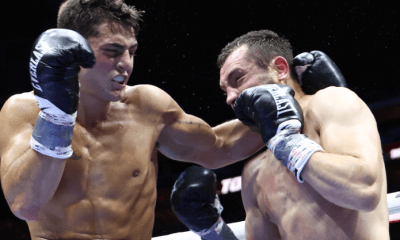
 Featured Articles3 weeks ago
Featured Articles3 weeks agoVito Mielnicki Jr Whitewashes Kamil Gardzielik Before the Home Folks in Newark
-
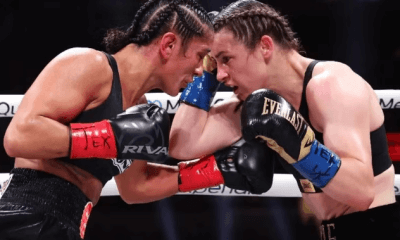
 Featured Articles7 hours ago
Featured Articles7 hours agoResults and Recaps from New York Where Taylor Edged Serrano Once Again
-
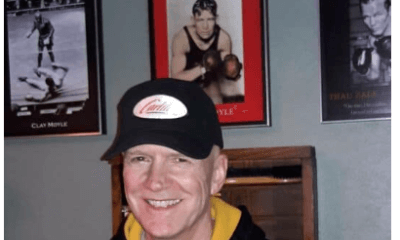
 Featured Articles4 weeks ago
Featured Articles4 weeks agoCatching Up with Clay Moyle Who Talks About His Massive Collection of Boxing Books
-

 Featured Articles5 days ago
Featured Articles5 days agoFrom a Sympathetic Figure to a Pariah: The Travails of Julio Cesar Chavez Jr
-
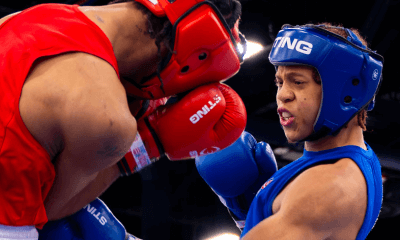
 Featured Articles3 weeks ago
Featured Articles3 weeks agoMore Medals for Hawaii’s Patricio Family at the USA Boxing Summer Festival
-
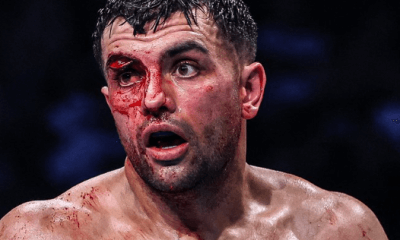
 Featured Articles7 days ago
Featured Articles7 days agoCatterall vs Eubank Ends Prematurely; Catterall Wins a Technical Decision
-
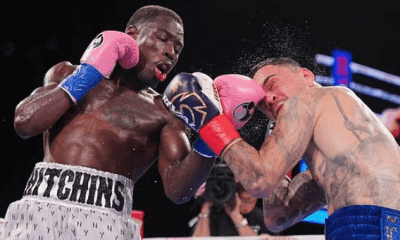
 Featured Articles4 weeks ago
Featured Articles4 weeks agoRichardson Hitchins Batters and Stops George Kambosos at Madison Square Garden

















